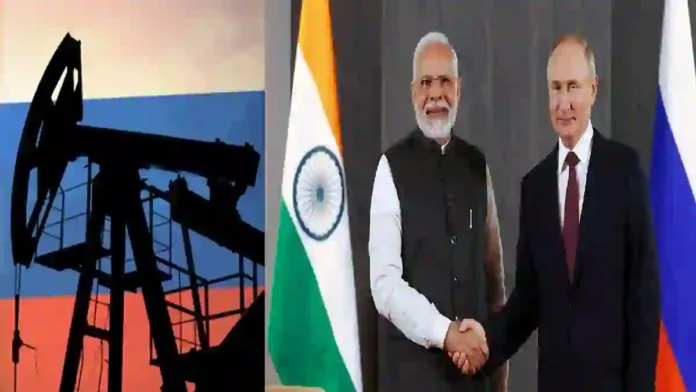Russia has reaffirmed its commitment to maintain robust energy ties with India by offering a 5 percent discount on crude oil sales, despite mounting international and U.S.-driven pressure over the Ukraine conflict. This announcement, made by Russian Deputy Trade Representative to India, Evgeniy Griva, underscores Moscow’s strategy of securing its energy market in Asia, particularly in response to Western sanctions that have increasingly isolated Russia from European buyers.
Griva noted that the discount, although subject to negotiation, reflects a longstanding commercial practice where fluctuations typically hover around the ±5% range. He emphasised that notwithstanding geopolitical tensions, India’s level of oil imports from Russia will remain stable, reflecting mutual economic pragmatism and trust in bilateral energy cooperation.
Read- Air Launched Variant of Pralay Is At An Advanced Stage of Development; Testing In The Near Future
Russian Deputy Chief of Mission Roman Babushkin reinforced this message, characterising the current environment as a “challenging situation” for New Delhi given Washington’s sanctions, but highlighting Moscow’s confidence in India’s continued partnership.
Babushkin stressed that energy collaboration between the two nations is based on strategic trust and resilience, suggesting that Russia views India as a dependable partner even under the strain of Western economic coercion.
Analysts note that Russia’s competitive pricing and logistical adaptability provide India with an advantageous alternative to Middle Eastern and Western suppliers, particularly as global oil markets remain volatile.
In sharp contrast, the United States has adopted a confrontational stance, aiming to deter India from deepening its energy dependence on Russia. The Trump administration recently imposed 50% tariffs on Indian exports to the U.S., justifying the measures as an effort to curtail Russia’s access to global financial resources.
White House Trade Adviser Peter Navarro accused India of acting as a “global clearinghouse” for Russian crude oil, re-exporting refined products to world markets, and thus inadvertently financing Moscow’s war efforts in Ukraine. This approach represents Washington’s broader strategy of applying secondary pressure on Russia via its trade partners, in this case India, in order to constrain Kremlin revenues from energy sales.
Read- India Mulling To Order 114 Rafale To Replace Outdated Soviet Fighters
India has strongly condemned the U.S. measures, branding them “unfair, unjustified and unreasonable.” New Delhi has argued that such tariffs disproportionately harm its domestic industries, including textiles, marine products, and leather exports, all of which rely heavily on U.S. market access. Indian policymakers fear that extended tariff regimes could disrupt tens of thousands of jobs and strain already sensitive trade negotiations with Washington.
Prime Minister Narendra Modi has publicly vowed that India will not yield to external economic coercion, signalling a policy of strategic autonomy that seeks to balance its relationships with both Washington and Moscow without compromising national interests.
At a White House briefing, Press Secretary Karoline Leavitt defended the U.S. decision by stating that President Trump’s intent was not simply punitive but strategic—designed to increase “secondary pressure” on Russia in order to hasten an end to the Ukraine war.
She argued that the administration’s actions were consistent with its broader foreign policy, which seeks to leverage economic sanctions to compel behavioural change from adversaries and their partners. While the U.S. insists that these tariffs are crucial for escalating pressure on Moscow, critics argue that the collateral damage could alienate India, one of Washington’s most important partners in counterbalancing China’s influence in Asia.
The current standoff exposes India’s geopolitical tightrope walk. On one hand, Moscow offers India discounted oil, strengthening its energy security and supporting its industrial base. On the other, Washington’s prohibitive tariffs risk undermining access to key export markets, straining India-U.S. economic ties at a time when they were otherwise deepening through defence, technology, and supply chain cooperation.
Read- India Is Preparing To Acquire Nearly 450 Fighter Jets In The Coming Years
Moreover, China, alongside India, continues to be a major importer of Russian oil, meaning any U.S. sanctions directed at India could inadvertently push New Delhi closer to Beijing and Moscow, undermining broader Western strategic objectives in Asia.
In conclusion, Russia’s discounted oil offer reflects its pragmatic effort to preserve and deepen market access in India, while U.S. tariffs highlight the lengths to which Washington is willing to go to cut off Russia’s revenue streams. India’s refusal to buckle under external pressures underscores its pursuit of strategic autonomy in foreign policy.
Moving forward, the success of this strategy will depend on how effectively New Delhi navigates between the economic benefits of discounted Russian oil and the potentially severe trade repercussions with the United States. This evolving triangular dynamic between India, Russia, and the U.S. will continue to shape the balance of global energy and trade politics in the coming months.
Based On NDTV Report
Agencies




